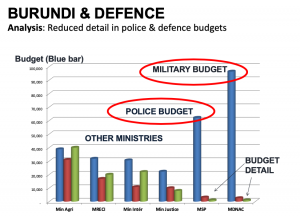Defence Budget transparency
Mark Pyman
There has been a history of defence budgets being kept out of the public eye, and parts of the defence budget being hidden within other ministry budgets. This is poor practice. Apart from genuinely secret items, usually a very small percentage of the total defence budget, there is no good reason not to publish the defence budgets.
As with the defence budgeting process, there is plenty of knowledge on what good practice looks like. Questions to ask include:
- Does the government publish a defence white paper or other official defence and security document?
- In law, are off-budget military expenditures permitted? In practice, are there any off-budget military expenditures?
- In law, are there provisions regulating the mechanisms for classifying information
on the grounds of protecting national security and military intelligence?
- Are regular reports (i.e. in- year, mid-year and year-end) regarding the execution of the defence budget published?
- Are defence and security sectors audited, and the information obtained made publicly available?
- Does the country submit defence budget information to regional or international organisations?
- Is there a freedom of Information act?
- Is the defence budget proposal made publicly available?
- Is the approved defence budget made publicly available?
- In practice, can citizens, civil society and the media obtain detailed information on defence budgets?
- Does the defence budget include comprehensive information, including military R&D, training, construction, personnel expenditures, acquisitions, disposal of assets, maintenance, etc.?
- Are reports pertaining to the execution of the defence budget made available to the public and to the legislature regularly (in- year, mid-year, year-end)?
Greater defence budget detail
Defence budgets should be as fully detailed and specified as for any other major Ministry. In some countries this is not true, with much less budget disaggregation, either in terms of the headings or the individual line items.
Example: BURUNDI

The defence and security budgets in Burundi were much less detailed than in other ministries, as at 2015. The chart below shows the size of the budgets (blue bar), the number of budget categories (red bar) and the number of budget lines (green bar) for 6 ministries; Agriculture, Economy, Interior, Justice Police and Defence (the scale on the left is shown only for the budget). Though the budgets for defence and police greatly exceed the budgets for other ministries, the number of budget headings and the number of budget lines are dramatically fewer.
Comparative country data from TI: defence budget transparency
Approximately one third of countries assessed as part of the TI defence countries database publish a defence budget that is detailed and transparent. These countries often have mechanisms in place allowing them to maintain a justifiable level of secrecy while ensuring that the defence budget is disclosed in a manner that means accountability can be enforced.